Sample Laboratory Biosafety Manual 样品实验室生物安全手册 英文版
医学院校实验室生物安全管理及防护

医学院校实验室生物安全管理及防护冯修猛;闫海润;李凯军【摘要】文章简要介绍了国内外实验室生物安全标准规范和水平分级的情况,并从目前的医学院校实验室生物安全现状出发,阐明了生物安全防护的重要性和必要性,进而从建立、健全规章制度,强化人员教育、培训,做好安全防护、体检免疫和实验室废弃物的处理等方面提出了实验室安全防护的对策.【期刊名称】《实验室科学》【年(卷),期】2010(013)003【总页数】3页(P174-176)【关键词】实验室生物安全;安全防护;医学院校【作者】冯修猛;闫海润;李凯军【作者单位】牡丹江医学院,教务处;牡丹江医学院,红旗医院,检验科,黑龙江,牡丹江,157011;牡丹江医学院,教务处【正文语种】中文【中图分类】R-012;Q-1随着生命科学和生物技术的发展,实验室生物安全日益受到人们的广泛关注。
世界卫生组织(WHO)在1983年就出版了《实验室生物安全手册》(Laboratory Biosafety Manual),并在2004年更新推出了第3版。
手册中根据不同危险等级微生物实验室的设计特点、建筑构造、防护设施、仪器的不同,将生物安全水平分为1~4级,以BSL-1、BSL-2、BSL-3和BSL-4表示。
在鼓励各国接受和执行生物安全的基本概念及针对本国实验室如何安全处理致病微生物、制订操作规范的基础上强调了工作人员个人责任心的重要性,并增加了危险性评估、重组DNA技术的安全利用以及感染性物质运输等新内容。
并介绍了生物安全保障的概念——保护微生物资源免受盗窃、遗失或转移,以免因微生物资源的不当使用而危及公共卫生[1]。
我国自2003年SARS暴发以来,国务院相继颁发了《病原微生物实验室生物安全管理条例》、《实验室生物安全通用要求》、《医疗废物管理条例》等一系列法规,将生物安全管理工作提到了议事日程。
这些法规的颁布及实施,将有利于我国实验室生物安全管理水平的提高,标志着我国实验室生物安全管理和实验室生物安全认可工作步入了科学、规范和发展的新阶段。
实验室生物安全法律法规

201307
2005/04/27
1
AMMS
概 述
实验室生物安全防护的发展
实验室生物安全法律法规和标准的发展
2005/04/27
2
AMMS
概 述
实验室生物安全防护技术的发展
二十世纪五十年代,美国在开展生物武器、
化学武器的实验室研究中,为了防止生物 因子(病原微生物)和化学毒剂泄漏逃逸 到实验室外环境,研制了一系列的防护装 备和设备,如高效粒子空气过滤器、生物 安全柜等;建设了BSL-3实验室和BSL -4实验室等。
概 述
遗传修饰微生物体的生物安全问题 重组DNA技术涉及到组合不同来源 的遗传信息,从而创造自然界以前可能从 未 存 在 过 的 遗 传 修 饰 生 物 体 (genetically modified microorganisms,GMMs)。最初,在分子 生物学家中有人担心这些生物体可能具有 不可预测的不良性状,一旦从实验室逸出 将带来生物学危害。这种担心在1975年美 国加利福尼亚州阿西洛马市召开的科学会 2005/04/27 11 议上成为焦点,会议上讨论了重组 DNA 技
2005/04/27 17
AMMS
《微生物和生物医学实验室生物安全手 册》(美国CDC/NIH,1999,第四版)
在 1983 年第一版的《微生物学和生物医学实验 室的生物安全》 (BMBL) 中,最早提出了把病原 微生物和实验室活动分为四级的概念。 1993 年 由CDC/NIH有关专家编写的《微生物和生物医学 实验室的生物安全》的第三版着重描述了微生 物实验室标准操作、实验室设计和安全设备的 不同组合,形成 1 ~ 4 级的实验室生物安全防护 等级,并依据微生物对人的危险程度分为四级 危险组,在实验室实际操作中加以应用。
实验室生物安全管理手册

××CADC/PGL-01-2010实验室生物安全管理手册(第一版)2010年1月6日颁布 2010年1月20日生效××疫病预防控制中心××疫病预防控制中心实验室生物安全管理手册(手册版号:第1版)编制人:审核人:批准人:颁布日期:2010年1月6日生效日期:2010年1月20日受控状态:□受控□非受控发放/受控编号:持有人:关于颁布实施《实验室生物安全管理手册》的通知中心全体工作人员:为确保实验室所从事的活动符合生物安全要求,将实验室安全风险降到最低程度,本中心根据有关法律、法规、标准编写了《实验室生物安全管理手册》,对影响实验室生物安全的各要素进行了有效控制,是中心实验室生物安全管理运行的依据和指南,是开展各种实验活动的规范性文件和准则。
本手册第1版于2010年1月6日颁布,2010年1月20日起实施。
全体工作人员必须认真学习,正确领会,全面掌握,并严格执行。
在手册执行过程中如有不适当之处,请及时向生物安全委员会提出意见,以便改进,确保生物安全管理体系运行的持续性和有效性。
××疫病预防控制中心主任:二〇一〇年一月六日第1章概述 (1)第2章术语、定义和缩略语 (4)第3章管理方针与目标 (6)第4章《生物安全管理手册》的管理 (7)第5章生物安全管理体系 (9)第6章组织机构与岗位职责 (12)第7章文件管理 (18)第8章人员 (20)第9章危害程度分级和风险评估 (22)第10章生物安全防护水平分级和防护屏障 (25)第11章菌(毒)种的管理 (26)第12章设施设备要求 (27)第13章个人防护装备 (30)第14章良好内务行为 (32)第15章安全工作行为 (33)第16章化学品安全 (35)第17章紫外线、微波、低温、高温高压 (36)第18章电气设备 (37)第19章消防安全 (38)第20章水灾及其他自然灾害 (40)第21章紧急撤离 (41)第22章样品的运送 (42)第23章废弃物处理 (43)附录1 生物安全实验室平面图 (44)附录2实验室操作生物因子及其危害程度分级一览表 (44)附录3 主要仪器设备、防护设备一览表 (51)附录4 中心工作人员一览表 (52)第1章概述1.1 实验室名称、地址、通讯方式1.1.1 实验室名称:××疫病预防控制中心1.1.2 地址:广州市海珠区万寿路113号;邮政编码:5102301.1.3 通信方式电话:传真:电子邮箱:1.2 实验室简介1.2.1 机构由来与编制情况…………1.2.2 机构性质与任务本中心是××省****厅属下参照公务员法管理的事业单位,是《中华人民共和国动物防疫法》的执法主体,行使《中华人民共和国动物防疫法》和《××防疫条例》赋予的职能。
GB19489-2008《实验室 生物安全通用要求》相关内容
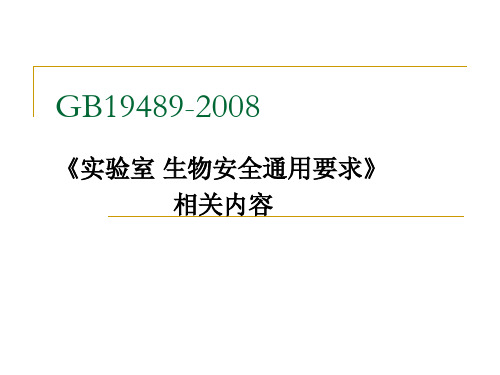
BSL-2标准微生物操作规程
5、必须制定并执行如针头、刀片、碎玻璃等锐器的安 全处置方案。只要可能,实验室主管要采用可以降低 锐器损伤风险的装置和实验控制措施。在处理锐器时 通常必须特别注意,做到如下几点: a、首要一点是必须小心处理针头及其他锐器。针 头在丢弃并不得弯曲、截断、打破、回套针头护套、 从一次性注射器上取下以及徒手操作。 b、使用过的一次性针头和注射器必须小心置于恰 当位置的用于盛放锐器的耐刺破容器中。 c、非一次性锐器必须置于硬壳容器中转移到 消毒的地方,最好采用高压灭菌。 d、打破的玻璃器具不能直接用手处理。而必须用 扫帚、簸箕、钳子或镊子来清除。 只要可能,尽量用塑料器皿代替玻璃器皿。
BSL-2实验室的个体防护
3、 必须佩戴手套以免双手暴露于危险材料。要根据风险评估结 果来选择适当的手套。要备有乳胶手套的替代品。手套不得带离 实验室外。此外,BSL-2工作人员还应: a、每当污染、破损或其他必要的时候,均要更换手套。适当时 要带双层手套。 b、每当操作危害性材料的工作结束时,以及离开实验室之前, 要脱去手套并洗手。 c、一次性手套不得清洗或重复使用。将使用过的手套和其他实 验室污染废弃物一 起处理。要严格遵守洗手的规程。 4、 房间内有感染性动物时,要在风险评估后确定是否需要使用 眼睛、面部和呼吸防护装备。
《可感染人类的高致病性病原微生物菌(毒)种或样本运输管理规定》,卫 生部,2006.02 《高致病性动物病原微生物菌(毒)种或者样本运输包装规范》,农业部, 2005.05
实验室活动(第21条)
■ 一级、二级实验室
不得从事高致病性病原微生物实验活动。
■ 三级、四级实验室 从事高致病性病原微生物实验活动应具备下列条件: (一)实验目的和拟从事的实验活动符合国务院卫生主管部门规定; (二)通过实验室国家认可; (三)具有与拟从事的实验活动相适应的工作人员; (四)工程质量经建筑主管部门依法检测验收合格。 ■ 经国务院卫生审查后,对符合条件的三级、四级实验室发给从事 高致病性病原微生物实验活动的资格证书。
生物安全实验室操作技术规范
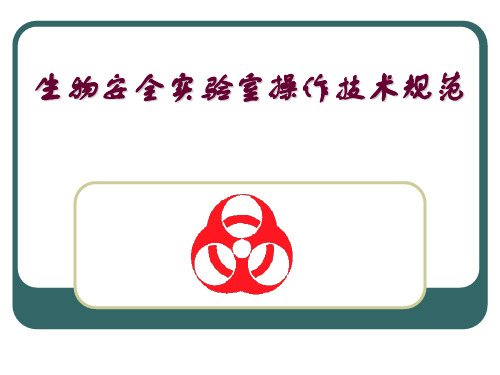
气溶胶. 气溶胶 物战剂的气溶胶.气溶胶喷洒是国外生物战释放生物战 物战剂的气溶胶.
剂的主要方式. 剂的主要方式.
6. 生物战剂气溶胶 (bio-agent aerosol):分散相含有生 :
生物学相关概念
7.生物危害 (bio-hazard)和生物危险 (bio-risk):生物 危害是由生物因子形成的伤害.生物危险 (bio-risk)是 生物因子将要或可能形成的危害,是伤害概率和严重性的 综合. 8.危险废物(hazardous waste):即有潜在危险的废物, 即可燃,易燃,腐蚀,有毒,传染,放射或其他破坏作用 的废物
我国对具体病原微生物的分类详见卫 生部颁布的《人间传染的病原微生物名 录》.该名录除对病原微生物的危害分类 标准除进行危害程度分类外,还规定了其 不同实验操作的防护水平以及运输的包装 要求.
WHO安全手册 WHO安全手册
( 个体危险 高,群体危险 低) 病原微生物通 常能引起人或 动物的严重疾 病,但一般不 会发生感染个 体向其他个体 的传播,并且 对感染有有效 的预防和治疗 措施.
国内外病原微生物危害程度分类比较
管理条例
一 类 能够引起人类 或者动物非常 严重疾病的微 生物,以及我 国尚未发现或 者已经宣布消 灭的微生物. 灭的微生物 Ⅳ 级
通用要求
(高个体危害, Ⅳ 高群体危害) 级 能引起人类或 动物非常严重 的疾病,一般 不能治愈,容 容 易直接或间接 或因偶然接触 在人与人, 在人与人 , 或 动物与人, 动物与人 , 或 人与动物, 人与动物 , 或 动物与动物间 传播的病原微 传播 生物.
WHO安全手册 WHO安全手册
(个体和群体 的危险均高) 病原微生物通 常能引起人或 动物的严重疾 病,并且很容 很容 易发生个体之 间的直接或间 接传播,对感 接传播 染一般没有有 效的预防和治 疗措施.
实验室生物安全培训总结报告

2024年实验室生物安全培训总结报告在过去的12个月里,我们实验室团队在生物安全领域的培训和实践上取得了显著的进步。
本报告旨在总结我们在提升实验室生物安全水平方面的努力和成就,同时为未来的工作提供宝贵的经验和改进方向。
一、培训概述在过去的一年中,我们实验室全体成员积极参与了由权威机构组织的生物安全培训课程。
这些课程涵盖了从基础理论到高级实践的各个方面,包括但不限于实验室生物安全等级(BSL)的识别、个人防护装备的使用、病原体处理和储存、生物安全柜的操作、以及意外事件的处理等。
通过这些培训,我们团队成员的理论知识和实际操作技能都得到了显著提升。
二、培训内容与评估在理论培训方面,我们深入学习了最新的生物安全政策和指南,例如《实验室生物安全手册》(Laboratory Biosafety Manual, 4th Edition)和国际生物安全标准(ISO 22442)。
这些学习帮助我们理解了生物安全的重要性,以及在日常工作中如何遵守相关的法规和标准。
实践操作培训是我们培训计划中的重要组成部分。
通过模拟演练和实际操作,我们掌握了如何在不同的生物安全等级下工作,如何正确使用个人防护装备,以及如何安全地处理和储存各种病原体。
此外,我们还学习了如何维护和校准生物安全设备,以确保实验室始终处于最佳的生物安全状态。
为了评估培训效果,我们进行了定期的考核和反馈。
这些评估不仅检验了团队成员的理论知识,还检验了他们在实际操作中的技能和决策能力。
通过这些评估,我们能够及时发现并纠正潜在的问题,确保每位成员都能达到预期的生物安全标准。
三、培训成果与案例分析通过系统的生物安全培训,我们实验室在多个方面取得了显著的成果。
首先,我们的团队成员能够更加自信和熟练地处理各种生物安全相关任务。
其次,实验室的生物安全记录显著改善,意外事件的发生率明显降低。
最后,我们的培训经验还为其他实验室提供了宝贵的参考和指导。
案例分析:在一次培训后,我们的团队成功地处理了一起意外泄漏事件。
动物实验室生物安全
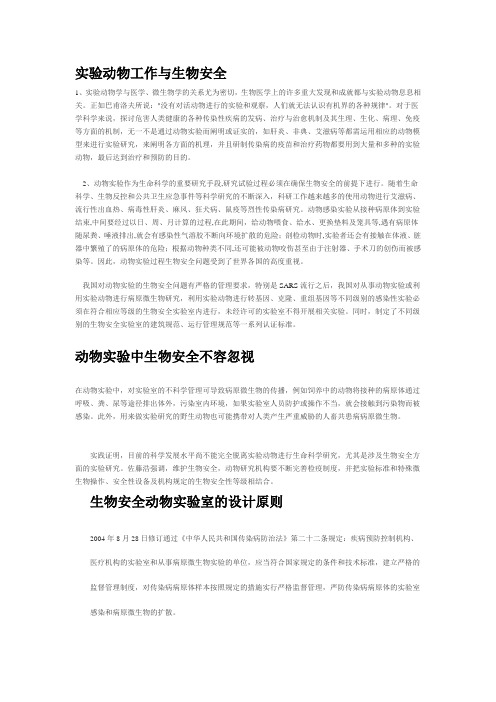
实验动物工作与生物安全1、实验动物学与医学、微生物学的关系尤为密切,生物医学上的许多重大发现和成就都与实验动物息息相关。
正如巴甫洛夫所说:"没有对活动物进行的实验和观察,人们就无法认识有机界的各种规律"。
对于医学科学来说,探讨危害人类健康的各种传染性疾病的发病、治疗与治愈机制及其生理、生化、病理、免疫等方面的机制,无一不是通过动物实验而阐明或证实的,如肝炎、非典、艾滋病等都需运用相应的动物模型来进行实验研究,来阐明各方面的机理,并且研制传染病的疫苗和治疗药物都要用到大量和多种的实验动物,最后达到治疗和预防的目的。
2、动物实验作为生命科学的重要研究手段,研究试验过程必须在确保生物安全的前提下进行。
随着生命科学、生物反控和公共卫生应急事件等科学研究的不断深入,科研工作越来越多的使用动物进行艾滋病、流行性出血热、病毒性肝炎、麻风、狂犬病、鼠疫等烈性传染病研究。
动物感染实验从接种病原体到实验结束,中间要经过以日、周、月计算的过程,在此期间,给动物喂食、给水、更换垫料及笼具等,遇有病原体随尿粪、唾液排出,就会有感染性气溶胶不断向环境扩散的危险;剖检动物时,实验者还会有接触在体液、脏器中繁殖了的病原体的危险;根据动物种类不同,还可能被动物咬伤甚至由于注射器、手术刀的创伤而被感染等。
因此,动物实验过程生物安全问题受到了世界各国的高度重视。
我国对动物实验的生物安全问题有严格的管理要求,特别是SARS流行之后,我国对从事动物实验或利用实验动物进行病原微生物研究,利用实验动物进行转基因、克隆、重组基因等不同级别的感染性实验必须在符合相应等级的生物安全实验室内进行,未经许可的实验室不得开展相关实验。
同时,制定了不同级别的生物安全实验室的建筑规范、运行管理规范等一系列认证标准。
动物实验中生物安全不容忽视在动物实验中,对实验室的不科学管理可导致病原微生物的传播,例如饲养中的动物将接种的病原体通过呼吸、粪、尿等途径排出体外,污染室内环境,如果实验室人员防护或操作不当,就会接触到污染物而被感染。
实验室生物安全

内产品,目前已较少使用。
一级生物安全柜
图6 Ⅰ级生物安全柜原理图 A:前开口;B:窗口;C:排风HEPA 过滤器;D:压力排风系统
二级生物安全柜
是目前应用最为广泛的柜型;
依照入口气流风速、排气方式和循环方式
可将二级生物安全柜分为4个级别:
A1型, A2型(原B3型), B1型和B2型;
二级生物安全柜
传播危险有限。
当病源形成大量气溶胶的潜力较大时,
会增加人员感染的危险。
通常危害等级Ⅱ的微生物 都在初级生物学诊断、基
础医学研究上存在,需要
张贴生物危险标志。
实验室生物危害因子分级
危害等级Ⅲ的微生物 体危害):
(高个体危害、低群
即能引起人类或动物严重疾病,造成严重 经济损失,但通常不能因偶然接触而在个 体间传播,或能用抗生素、抗寄生虫药物 治疗的病原体。
足部防护装置
BSL-2和BSL-3实验室要
坚持穿鞋套或靴套;
BSL-3和BSL-4实验室要
求使用专用鞋。
生物安全柜
Biological safety cabinets,BSCs 是为操作原代培养物、菌毒株以及诊断性
标本等具有感染性的实验材料时,用来保
护操作者本人、实验室环境以及实验材料,
使其避免暴露于上述操作过程中可能产生
生物安全实验室分级及适用范围
Ⅳ级生物安全实验室
适用于对人体、动植物或环境具有高度的 危险性,通过气溶胶途径传播或传播途径 不明,目前尚无有效疫苗或治疗方法的致 病性微生物或未知传播风险的有关病原体 及其毒素。
一级屏障:Ⅲ级生物安全柜,正压防护服
二级屏障:在Ⅲ级BSL的基础上,应为单独
国际上关于病原微生物实验室的相关法规和指南
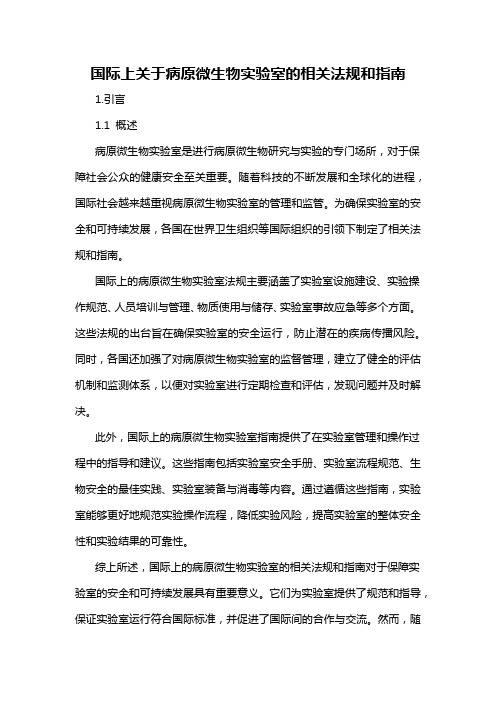
国际上关于病原微生物实验室的相关法规和指南1.引言1.1 概述病原微生物实验室是进行病原微生物研究与实验的专门场所,对于保障社会公众的健康安全至关重要。
随着科技的不断发展和全球化的进程,国际社会越来越重视病原微生物实验室的管理和监管。
为确保实验室的安全和可持续发展,各国在世界卫生组织等国际组织的引领下制定了相关法规和指南。
国际上的病原微生物实验室法规主要涵盖了实验室设施建设、实验操作规范、人员培训与管理、物质使用与储存、实验室事故应急等多个方面。
这些法规的出台旨在确保实验室的安全运行,防止潜在的疾病传播风险。
同时,各国还加强了对病原微生物实验室的监督管理,建立了健全的评估机制和监测体系,以便对实验室进行定期检查和评估,发现问题并及时解决。
此外,国际上的病原微生物实验室指南提供了在实验室管理和操作过程中的指导和建议。
这些指南包括实验室安全手册、实验室流程规范、生物安全的最佳实践、实验室装备与消毒等内容。
通过遵循这些指南,实验室能够更好地规范实验操作流程,降低实验风险,提高实验室的整体安全性和实验结果的可靠性。
综上所述,国际上的病原微生物实验室的相关法规和指南对于保障实验室的安全和可持续发展具有重要意义。
它们为实验室提供了规范和指导,保证实验室运行符合国际标准,并促进了国际间的合作与交流。
然而,随着科技的不断进步和研究领域的不断扩大,病原微生物实验室管理面临新的挑战,需要各国持续关注和改进。
在本文中,我们将深入研究国际上的病原微生物实验室法规和指南,并总结对实验室管理的启示和建议。
文章结构部分的内容应该包括对本文整体结构的说明,以及各个章节的简要概述。
在本文中,文章结构如下:1. 引言1.1 概述:介绍病原微生物实验室的背景和重要性,并概述国际上关于病原微生物实验室的法规和指南的研究现状。
1.2 文章结构:解释本文的整体结构和各个章节的内容,为读者提供一个清晰的指引。
1.3 目的:说明本文的目标和意义,即总结国际上关于病原微生物实验室的法规和指南,同时提出对病原微生物实验室管理的启示和建议。
Biosafety Level 3 (BSL-3) 实验室设计标准说明书

Biosafety Level 3 (BSL-3) LaboratoryDesign StandardsJanuary 2020CC Noncommercial LicenseThis manual is licensed under a Creative Commons Attribution-NonCommercial 4.0 International License. When reusing the content under this license,please provide (1) attribution to “Environment, Health & Safety at the University of California, Office of the President”; (2) the following copyright notice: © The Regents of the University of California; and (3) if feasible, a hyperlink to where the original source material appears.IntroductionThe University of California (UC) is home to some of the world’s most advanced and pioneering biomedical science and clinical research. Consistently ranked among the leaders in the field of Infectious Disease research, the UC is often called upon to provide critical expertise in response to worldwide public health crises. Infectious Disease research involving highly pathogenic and primarily aerosol transmissible agents (i.e., Risk Group 3 agents) has the potential to present significant risk to individuals, the community, and the environment. The ability to safely conduct these research activities is largely dependent upon the highly engineered Biosafety Level 3 (BSL-3) laboratory, the highest-level containment facilities currently operated by the UC. The primary objective of these laboratories is to provide the best possible physical containment of Risk Group 3 agents. Hence, the design and engineering of these laboratories must be maintained at the highest attainable standards.Several authorities have published standards for the design of BSL-3 laboratories. Development of the UC Biosafety Level 3 Design Standards has incorporated input from several of these sources, including the following:• CDC Biosafety in Microbiological and Biomedical Laboratories (BMBL), 5th Edition, 2009 • NIH Design Requirements Manual for Biomedical Laboratories and Animal Research Facilities (DRM), 2019• NIH Guidelines for Research Involving Recombinant or Synthetic Nucleic Acid Molecules (NIH Guidelines), 2016• National Institutes of Health Biosafety Level 3 Laboratory Certification Requirements, 2006• Industry Standards and Best PracticesThe information presented in these Standards addresses facility design and engineering systems for BSL-3 containment laboratories and incorporates additional design elements to assist campuses in conducting facility risk assessments. It is important to note that an effective BSL-3 program is not only reliant upon the facility and engineering, but also operation and maintenance (O&M) protocols, robust training programs, administrative controls, and standard operating procedures (SOPs).ApplicationThe BSL-3 Laboratory Design Standards represent the UC requirements for constructing BSL-3 laboratories. These Standards need to be referenced and used by UC design teams includingresearchers, architects and engineers, as well as outside contractors. They provide necessary tools and information for BSL-3 planning, construction, and commissioning on UC campuses. While incorporating all applicable regulatory requirements, the standards identify UC requirements, provide explanations of those standards, and document best practices for consideration during the facility risk assessment. This range of acceptable parameters will allow campuses to build each laboratory with a level of features commensurate with the facility risk assessment. These Standards pertain to new facility builds and/or major renovations or retrofits of existing BSL-3 laboratory space. It is not the intent of these Standards to require upgrades to existing BSL-3 spaces, but to provide design standards and guidance when embarking on a new construction or major renovation project.For the purposes of these Design Standards, major renovations/retrofits are defined as any of the following: 1. Changes to fixed primary containment equipment (e.g. ducted BSCs or any other devices connected to the BSL-3 exhaust system); 2. Changes to major HVAC systems/components (e.g. exhaust fans, air handling units, airflow control valves, isolation dampers, Building Management Systems / Building Automation Systems (BMS/BAS), ductwork, etc.); 3. Changes to floorplans or structural components of the secondary containment boundaries (e.g. walls, ceilings, or attached fixtures); 4. Any other changes to the facility that could impact overall safety, operations, or ventilation system performance. This Standard is applicable to the specific retrofit and not meant to apply to the entire facility. As plans to renovate specific features of an existing facility evolve, it is important to address any identified issues that may affect the safe operations of a BSL-3 laboratory, potentially presenting a risk to the UC community or the environment. These Standards have been approved by the UC systemwide High Containment Laboratory Oversight Committee (HCLOC), and shall be incorporated or referenced in Campus Building Standards.Note: Facilities required to comply with the Federal Select Agent Program and/or Dual Use Research of Concern may have additional biosafety or biosecurity design features beyond these UC Standards. In addition to the UC Standards, campuses must reference and comply with the applicable Federal regulatory standards when designing Federal Select Agent or Dual Use Research high-containment facilities.Campus InvolvementAt the onset of a new BSL-3 laboratory or existing laboratory renovation design project, it is important to consider the involvement of specific campus experts. Consultation with these key campus members may provide insight into critical design flaws that may affect specific aspects of the laboratory’s functionality. These contributions could prove to be exceptionally cost-effective interms of both time and resources. Involvement from the following campus members is recommended:• PI (researcher)/Department Chair• EH&S Biosafety• High Containment Laboratory Director• Campus Design Management Group• Capital Programs• UC Building Officials• Campus ADA Reviewer• Campus Security or Campus Police Department• Campus Emergency Response• Campus Fire Marshal• Campus Facilities Operations & Management GroupDeviationsCampuses must comply with the UC Biosafety Level 3 Design Standards and Best Practices should be considered when appropriate. When justified by a documented risk assessment, a deviation may be considered. A campus seeking a deviation approval must first complete the UC BSL3 Design Standards Deviation Request Form, Appendix I. The completed form and requested documentation shall be presented to the campus High Containment Laboratory Oversight Group (HCLOG) for approval. With campus HCLOG approval, the deviation request will be presented to the UC systemwide HCLOC, for final approval.Revisions to the StandardsA full review and revision of the UC BSL3 Design Standards shall be conducted every two years, on even years. Between full revisions, the Design Standards may be revised on an as needed basis via continual evaluation and application. Through the use of these Design Standards, any identified gaps, errors, or sections requiring further clarification will be noted and highlighted by local EH&S and Design professionals. Corrections, clarifications and all identified issues shall be presented to the UC systemwide HCLOC for confirmation and approval. Once approved by the HCLOC, updates will be completed and distributed to each location. Revised versions of the Standards must receive approval by the UC systemwide HCLOC prior to implementation.Table of ContentsList of Codes, Standards and Guidelines (1)BSL-3 Architectural (2)General (2)Containment Barrier (3)Anterooms (4)Doors (5)Windows (6)Floors (7)Base (7)Walls (7)Ceilings (8)Access Panels (9)Finishes (9)Furniture (10)Sealing (11)BSL-3 Architectural References (13)Heating, Ventilation & Air Conditioning (19)HVAC References (24)Electrical (27)Electrical References (34)Plumbing (38)Water Distribution (39)Vacuum Line (39)Sinks (40)Shower (41)Drains (41)Traps (42)Waste Pipe Cleanout (43)Plumbing References (44)Telecom, Security & Documentation (47)Telecom (47)Security (47)Signage (49)Enhanced Facilities (50)Verification & Documentation (50)Seismic (51)Telecom, Security & Documentation References (52)Safety and Decontamination (53)Safety (53)Decontamination (55)Safety and Decontamination References (57)BSL-3 Standard Equipment (59)Autoclaves (59)Biosafety Cabinets (60)Flow Cytometry (61)Centrifuge (61)BSL-3 Standard Equipment References (62)CC Noncommercial LicenseThis manual is licensed under a Creative Commons Attribution-NonCommercial 4.0 International License. When reusing the content under this license,please provide (1) attribution to “Environment, Health & Safety at the University of California, Office of the President”; (2) the following copyright notice: © The Regents of the University of California; and (3) if feasible, a hyperlink to where the original source material appears.List of Codes, Standards and Guidelines• Biosafety in Microbiological and Biomedical Laboratories (BMBL) 5th Edition, 2009 https:///labs/pdf/CDC-BiosafetyMicrobiologicalBiomedicalLaboratories-2009-P.PDFThe BMBL is published jointly by the U.S. Department of Health and Human Services, the Centers for Disease Control and the National Institutes of Health. The document describes Biological risk assessment, lab practices, safety equipment, and facilities requirements required for designing and operating laboratories at Biosafety Levels (BSL) 1 through 4. Although not a code, certification of BSL facilities is dependent on following the recommendations in thisdocument.• NIH Design Requirements Manual (DRM) 2019 Rev 1.4: 4/24/19https:///TechnicalResources/Documents/DRM/DRM1.4042419.pdf• National Institutes of Health Biosafety Level 3 Laboratory Certification Requirements,July 2006 https:///PoliciesAndGuidelines/Bioenvironmental/Documents/BSL-3CertificationGuidelinesFINAL_508.pdf• ANSI/ASSE Z9.14-2014 Testing and Performance-Verification Methodologies for Ventilation Systems for Biosafety Level 3 (BSL-3) and Animal Biosafety Level 3 (ABSL-3) Facilities -This document can be purchased at: https:///PersonifyEbusiness/Store/Product-Details/productId/11562952• NIH Guidelines for Research Involving Recombinant or Synthetic Nucleic Acid Molecules (NIH Guidelines), 2016• University of California Environment, Health & Safety (EH&S) Laboratory Safety Design Guide, Second Edition, September 2007。
实验室生物安全手册

兽医实验室生物安全手册2012年1月1日发布2012年1月1日实施动物疫病预防控制中心批 准根据国务院《病原微生物实验室生物安全管理条例》。
对照国家标准《实验室 生物安全通用要求(GB19489-2008)》,及农业部相关管理规定,我实验室结合实际工作情况,编制了《___动物疫病预防控制中心兽医实验室生物安全管理手册》。
本手册具体描述了我中心生物安全管理体系的各个要素,是实验室做好生物安全管理的纲领性文件和重要依据。
本手册现已批准,并予发布,自发布之日实施。
实验室全体成员及相关人员应认真学习,严格遵照执行,确保实验室每个环节的生物安全都有效控制,防止实验室感染和病原微生物扩散,保护实验室人员和公众健康。
主任:2012年1月1日目录第一章前言第二章生物安全方针与目标第三章术语与定义第四章组织第五章管理体系第六章文件第七章安全计划第九章不符合项的识别和控制第十章纠正措施第十一章预防措施第十二章持续改进第十三章内部审核第十四章管理评审第十五章人员管理第十六章材料管理第十七章活动管理第十八章内务管理第十九章设施设备第二十章废物处置第二十一章危险材料运输第二十二章应急措施第二十三章消防安全第二十四章事故报告订页发放控制本手册共印制8本,实际发放5本,报省疫控中心1本,剩下2本由--负责保管。
实验室生物安全管理手册是受控文件,手册和电子档的持有人、保管人有责任妥善保管,除监督评审部门检查外,未经实验室主任许可不得将手册(或电子档)外借和赠送非本实验室人员。
发放人名单第一章前言1.1 简介动物疫病预防控制中心(简称:中心)是依法成立的财政全额拨款事业单位,隶属于…。
主要职责是依据《中华人民共和国动物防疫法》组织实施全区动物防疫工作,调查动物疫情并组织实时控制和扑灭工作;负责全区动物疫病的实验室检测工作;负责全区动物疫情监测、预警预报工作等。
中心现有技术人员3名,其中实验室专职技术人员3名,兽医师1名,助理兽医师1名,实验员1名;实验室面积200平方米,设置解剖室、接样室、样品保存室、档案资料室、洗涤消毒室、血清学检测室、病原学检测室、共7个功能实验室(具体位置见实验室平面图);拥有生物安全柜等各类仪器设备38台套。
临床实验室生物安全指南说明书

ICS点击此处添加ICS号CCS 点击此处添加CCS号WS 中华人民共和国卫生行业标准XX/T XXXXX—XXXX代替 XX/T临床实验室生物安全指南Guidelines for clinical laboratory biosafety(点击此处添加与国际标准一致性程度的标识)(征求意见稿)在提交反馈意见时,请将您知道的相关专利连同支持性文件一并附上。
XXXX-XX-XX发布XXXX-XX-XX实施目次前言............................................................................II1 范围 (1)2 规范性引用文件 (1)3 术语和定义 (1)4 实验室生物安全风险管理 (3)5 实验室设计原则及基本要求 (5)6 实验室设施和设备要求 (6)7 实验室管理要求 (7)附录A(规范性附录)临床实验室良好工作行为指南 (16)附录B(规范性附录)临床实验室生物危险物质溢洒处理指南 (18)附录C(规范性附录)临床实验室风险评估样表 (21)附录D(规范性附录)临床实验室工作人员个体防护装备选用原则 (23)参考文献 (26)前言本标准按照GB/T 1.1—2020《标准化工作导则第1部分:标准化文件的结构和起草规则》的规定起草。
本标准起草单位:中国医科大学附属第一医院、国家医学检验临床医学研究中心、解放军总医院第五医学中心、上海市东方医院(同济大学附属东方医院)、华中科技大学同济医学院附属同济医院、江苏疾病预防控制中心、军事科学院军事医学研究院、北京市朝阳区疾病预防控制中心、国家卫生健康委临床检验中心。
本标准主要起草人:尚红、毛远丽、吴文娟、孙自镛、谢景欣、陆兵、张晓曦、彭明婷、耿文清、褚云卓、赵敏。
本标准代替WS/T 442-2014《临床实验室生物安全指南》。
与WS/T 442-2014相比,除结构调整和编辑性改动外,主要技术变化如下:增加了规范性引用文件、术语和定义中病原微生物、清洁、风险管理、风险应对、风险识别、风险分析、风险评价、风险准则、利益相关方。
Laboratory Biosafety Manual(实验室生物安全手册,英文版)
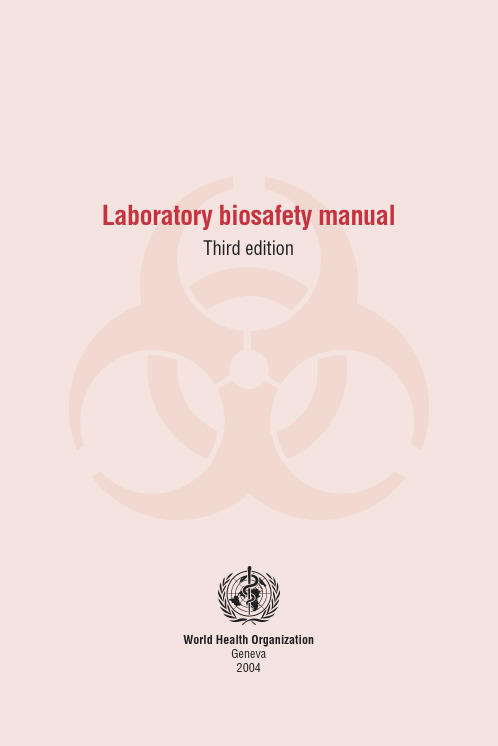
74
Standard precautions with blood and other body fluids, tissues and excreta
74
Precautions with materials that may contain prions
76
13. Contingency plans and emergency procedures
29
Animal facility – Biosafety Level 3
30
Animal facility – Biosafety Level 4
31
Invertebrates
32
7. Guidelines for laboratory/facility commissioning
33
8. Guidelines for laboratory/facility certification
25
Code of practice
25
Laboratory design and facilities
25
6. Laboratory animal facilities
28
Animal facility – Biosafety Level 1
29
Animal facility – Biosafety Level 2
64
PART IV. Good microbiological techniques
67
12. Laboratory techniques
69
Safe handling of specimens in the laboratory
69
Use of pipettes and pipetting aids
实验室生物安全法律、法规及标准
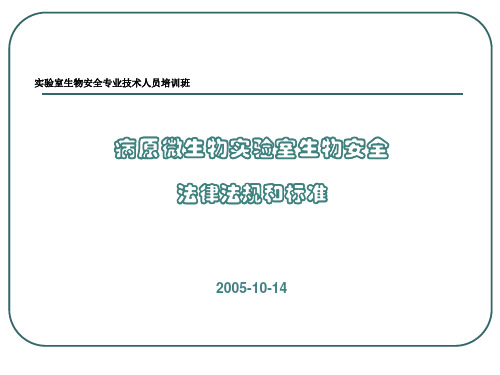
一、中国实验室生物安全法律、法规及标准(6)
标准——《实验室 生物安全通用要求》GB19489-2004(续) 主要内容 1.范围 11.安全工作行为 2.术语和定义 12.化学品安全 3.危害程度分析 13.放射安全 4.生物危害评估 14.紫外线和激光光源(包括高强度光源的光线) 5.防护屏障和生物安全水平分级 15.电气设备 6.设施和设备要求 16.防火 7.动物实验室的生物安全 17.水灾和其他自然灾害 8.个人防护装备 18.紧急撤离 9.管理要求 19.样本的运送 10.良好内务行为 20.废弃物处置
开创性 标准
一、中国实验室生物安全法律、法规及标准(9)
认可文件(中国实验室国家认可委员会,CNAL) 准则——《实验室生物安全认可准则》CNAL/AC30:2005 (2005.1.1生效,中国实验室国家认可委员会) 是《实验室 生物安全通用要求》和《病原微生物实验 室生物安全管理条例》的“杂合体” 规则——《实验室生物安全认可程序规则》(试行) CNAL/AR13:2004 (2005.1.1生效,中国实验室国家认可委员会) 信息—— 《实验室生物安全认可申请书》 CNAL/AI08:2003 (2005.1.1生效,中国实验室国家认可委员会)
一、中国实验室生物安全法律、法规及标准(7)
标准——《生物安全实验室建筑技术规范》GB50346-2004 Architectural and technical code for biosafety laboratories (2004.8.3 建设部、国家质量监督检验检疫总局联合发布,2004.9.1实施) 共10章,3个附录。主要内容: 1.规定了生物安全实验室建筑平面布局、装修和结构的技术要求。 2.实验室的基本技术指标要求。 3.对空调、通风和净化部分规定了气流组织、系统构成及系统部件和材料的选 择方案,以及构造和设计要求。 4.规定了实验室的给排水、气体供应、配电、自动控制和消防设施配置的原则。 5.对施工、检测个验收的原则、方法等做出了必要的规定。
实验室病原微生物危害评估报告
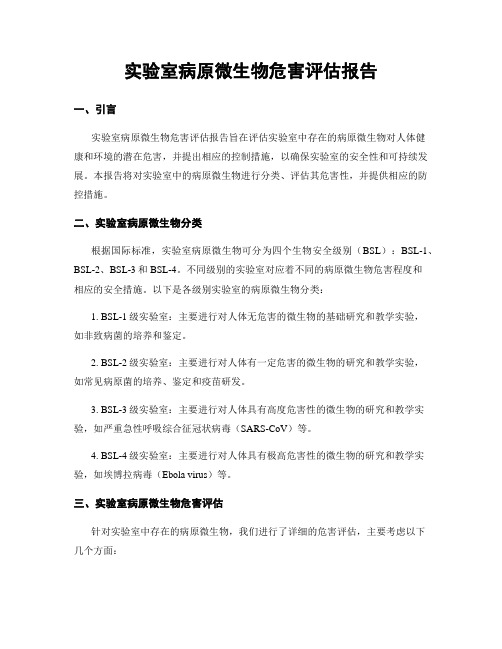
实验室病原微生物危害评估报告一、引言实验室病原微生物危害评估报告旨在评估实验室中存在的病原微生物对人体健康和环境的潜在危害,并提出相应的控制措施,以确保实验室的安全性和可持续发展。
本报告将对实验室中的病原微生物进行分类、评估其危害性,并提供相应的防控措施。
二、实验室病原微生物分类根据国际标准,实验室病原微生物可分为四个生物安全级别(BSL):BSL-1、BSL-2、BSL-3和BSL-4。
不同级别的实验室对应着不同的病原微生物危害程度和相应的安全措施。
以下是各级别实验室的病原微生物分类:1. BSL-1级实验室:主要进行对人体无危害的微生物的基础研究和教学实验,如非致病菌的培养和鉴定。
2. BSL-2级实验室:主要进行对人体有一定危害的微生物的研究和教学实验,如常见病原菌的培养、鉴定和疫苗研发。
3. BSL-3级实验室:主要进行对人体具有高度危害性的微生物的研究和教学实验,如严重急性呼吸综合征冠状病毒(SARS-CoV)等。
4. BSL-4级实验室:主要进行对人体具有极高危害性的微生物的研究和教学实验,如埃博拉病毒(Ebola virus)等。
三、实验室病原微生物危害评估针对实验室中存在的病原微生物,我们进行了详细的危害评估,主要考虑以下几个方面:1. 病原微生物的传播途径:通过空气传播、飞沫传播、接触传播、消化道传播等途径,评估其对实验室人员和周围环境的潜在危害。
2. 病原微生物的致病性:评估病原微生物对人体的致病性,包括感染途径、潜伏期、临床症状等,以确定其对实验室人员的危害程度。
3. 实验室操作风险:评估实验室操作过程中可能存在的风险,如操作失误、设备故障等,以确定实验室内部的安全控制需求。
4. 实验室安全设施:评估实验室的安全设施是否符合相应的生物安全级别要求,包括通风系统、生物安全柜、个人防护装备等。
四、实验室病原微生物危害防控措施针对实验室病原微生物的危害,我们提出以下防控措施,以确保实验室的安全:1. 实验室管理:建立完善的实验室管理制度,包括人员培训、操作规范、事故应急预案等,提高实验室人员的安全意识和操作技能。
动物实验生物安全
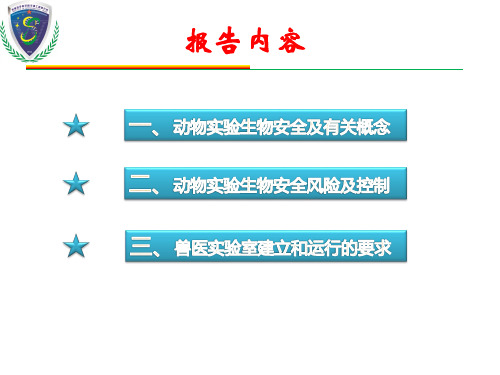
生物危害biohazard
从广义上:指有害的或有潜在危害的生物因子对人、环 境、生态和社会造成的危害或潜在危害。
从狭义上:指操作生物因子的过程和结果对人员以及环 境所造成的危害。
Biohazard--An agent of biological origin that has the capacity to produce deleterious effects on humans, i.e. microorganisms, toxins and allergens derived from those organisms; and allergens and toxins derived from higher plants and animals.
生物危害biohazard
危害对象:人类、动物、植物 危害因子:病毒;细菌、放线菌、衣原体、支原体、立克次
体、螺旋体;真菌(血吸虫等;转基因);毒素
生物安全 biosafety
➢ A series of procedures in the laboratory to ensure that pathogenic microbes are safely contained. - Guideline for Research Involving Recombinant DNA Molecules, NIH, USA, 1976
某实验室的工作人员突然发生高热,腹泻,呕吐,大出血,休克和 循环系统衰竭,此种症状同样出现在其他2个实验室)— —这3个
实验室都使用过来自乌干达的猴子,用于脊髓灰质炎疫苗等研究 。最后共37 人,包括实验室人员、医务人员及其亲戚都感染了疾
病,7人死亡。3个月后才找到罪魁祸首:一种危险的新病毒-- -马堡病毒。
- 1、下载文档前请自行甄别文档内容的完整性,平台不提供额外的编辑、内容补充、找答案等附加服务。
- 2、"仅部分预览"的文档,不可在线预览部分如存在完整性等问题,可反馈申请退款(可完整预览的文档不适用该条件!)。
- 3、如文档侵犯您的权益,请联系客服反馈,我们会尽快为您处理(人工客服工作时间:9:00-18:30)。
Sample Laboratory Biosafety Manual for Microbiological ActivitiesAccording to the CDC Biosafety in Microbiological and Biomedical Laboratories (BMBL) 5th Edition found at:“Each laboratory should develop or adopt a biosafety or operations manual that identifies the hazards that will be encountered, and that specifies practices and procedures designed to minimize or eliminate exposures to these hazards. Personnel should be advised of special hazards and should be required to read and follow the required practices and procedures. A scientist, trained and knowledgeable in appropriate laboratory techniques, safety procedures, and hazards associated with handling infectious agents or materials must be responsible for the conduct of work with any infectious agents or materials. This individual should consult with biosafety or other health and safety professionals with regard to risk assessment.” (BMBL, 5th Edition, Section III, Page 32, Laboratory Practice and Techniques).A laboratory biosafety manual should be readily available to assist investigators, technicians, and collaborators in routine and/or emergency operations using rDNA or infectious materials. The lab Biosafety Manual should also be available to safety, and emergency response personnel in case of an incident, accident, or an emergency in a specific lab area. It should be a working document, reviewed periodically, updated as necessary, and readily accessible to all personnel working in a lab or area with infectious and/or recombinant agents - preferably kept in the work area.A signature sheet that documents that all appropriate lab personnel working with infectious and/or recombinant agents have read and understand the provided information and/or materials should be a part of the lab Biosafety Manual. Dates of review by personnel should be on the signature sheet. (The BMBL requires at least annual updates on training – see above)A loose-leaf binder that can easily accommodate changes or new materials is the recommended option for maintaining a laboratory Biosafety Manual.The laboratory biosafety manual should be a living, working document that is an important resource for personnel engaged in the activities using biological and / or rDNA materials. Its primary focus should be to provide pertinent information to help execute the operations of the lab in a safe and professional manner.Contact the URCO (2-3224, comply@) if you have questions or need informationregarding the laboratory biosafety manualSample Laboratory Biosafety Manual TemplateAdministrative Information:Key Personnel: (provide current contact information for all key personnel) i.e. phone #, etc Principle Investigator:Co-Investigator(s):Technicians:Building and Lab Room Number:Biological / rDNA agent in use:Date Manual Prepared:Date of items last modified:IBC Registration Document Title, Number(s), and Date Approved:o A copy of the IBC Registration Document should be included in the Biosafety ManualIACUC Protocol Number (if applicable):Containment (Biosafety) Level Assigned:BSL-1Animal BSL-1BSL-2Animal BSL-2BSL-3Animal BSL-3OtherBiological Agent Information:o Biological Agents in Use:o Agent specific MSDS sheets and agent information (If available):o Susceptible populationo Route of infectiono Infective doseo Clinical sign of infectiono Treatmento ProphylaxisHelpful links below:o Public Health Agency of Canada (http://www.phac-aspc.gc.ca/msds-ftss/index-eng.php)o Center for Food Security and Public Health(/DiseaseInfo/imagedatabase.htm)o Center for Disease Control and Prevention(/OD/ohs/biosfty/bmbl5/bmbl5toc.htm)o Agent Location and Storage: (specify location and containment equipment for each agent by room, freezer, incubator, hood, etc.)o Occupational Health Information: (include targeted fact sheets that specify the agent, and information on occupational risks that may be posed by theagent. The animal care and use website has a number of fact sheets onoccupational risks that could serve as examples for fact sheets for youractivities – please consult the Fact Sheets located within the OccupationalHealth and Safety page)Agent Risk Assessment for Specific Agent and Project: (A comprehensive risk assessment is a critical element of the biosafety manual. The PI is responsible for identifying what the risks are for lab personnel or others working with the agent in the laboratory. Examples might be sharps hazards, aerosol hazards, animal bites or exposures, spills, splashes, etc.) Safety and Security/Standard Opera ting Procedures (SOP’s): (include copies of applicable SOPs in the binder for things like decontamination, disposal, security, emergency procedures, handling procedures, etc.)o Location of spill clean-up kit:o Agent spill clean-up procedure:o PPE required: Include PPE requirements for lab access with no agent manipulation, agent manipulation, agent manipulation with potentialaerosol production, animal handling, ect.o Infectious waste disposal: Describe for disposal of liquid and solid waste.o Sharps policy:o Aerosol reduction: Describe specific procedures that will be utilized to prevent aerosol production in the lab.Security Provisions: (describe agent security procedures appropriate to assigned agent BSL level)Emergency Procedures: (list procedures to be followed in case of an accident such as a spill, injection, ingestion, aerosolization, splash, etc.)o Other agent specific actions:∙Known first aid procedures∙Effective disinfectants / neutralizing agents (include location in lab)∙Known resistance traits introduced into agent(s)∙Known symptoms associated with exposures to this agent(s)Emergency Notification:1.Call primary investigator (phone #)2.Call Campus Police, Security, emergency medical personnel, etc (phone #’s)Training: Records of appropriate training (technical, safety, procedural, etc.) of lab personnel should be included in the Biosafety Manual. If maintained elsewhere, these records must be available for review by regulatory and compliance personnel.Institutional Notification Requirement: It is the responsibility of the PI to make appropriate notifications in the wake of an occupational exposure, laboratory accident, loss of potential containment, etc. The IBC and EH&S should be notified of incidents or adverse events involving biological agents or toxins.*This manual should be available for review by appropriate campus and / or regulatory personnel upon requestSignature Page for Laboratory PersonnelMy signature below affirms that I have received appropriate training for working with the organism(s) described in this biosafety manual, and I have read and understand the contents of the manual. I know the locations of all safety devices and equipment appropriate for the safe handling and decontamination of this/these organism(s).Signature Date____________________________ ______________________________ ____________________________ ______________________________ ____________________________ ______________________________ ____________________________ ______________________________。
